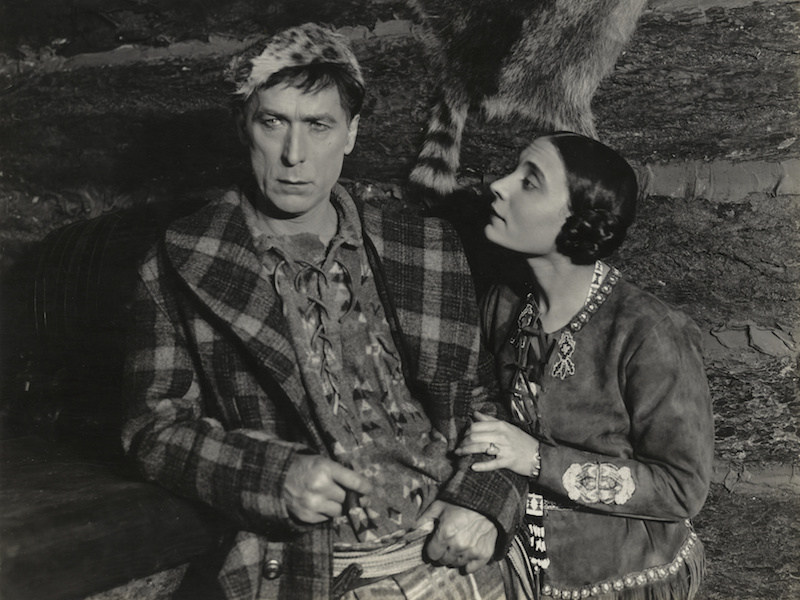BLUE BLAZES RAWDEN
William S. Hart (US 1918)
Blue Blazes Rawden was Hawks’s second treatment of a story first produced with Hart as Keno Bates, Liar. It provides a useful study of the process by which the industry expanded two-reel dramas to five-reel features. Hart seized the opportunity to create adult drama faithful to his vision of Western values, taking full advantage of his new Artcraft contract and the lavish range of opportunities it provided.
First, location work was far more expansive. The “forest frontier” was a popular variation on sagebrush hills for Hart’s scenarists. Blue Blazes Rawden is set in the Canadian Northwest of the 1880s, at a rough outpost teeming with Indians, émigrés, and local woodsmen. The lumber and limestone depot of Felton, California, situated in a large sequoia preserve south of San Francisco, stands in for the outskirts of Timber Cove. Elaborate Far North Saloon interiors, the work of Ince’s up-and-coming art director, G. Harold Percival, took up the whole of Hart’s production unit at the Lasky facilities. A rather florid opening title and the stunning cinematography of longtime collaborator Joe August sets an elegiac mood familiar in westerns since Owen Wister, with a nod to already existing Californian concerns about their redwoods. Rawden, drive crew boss, places his hand on a huge fallen tree like a big-game hunter claiming his prey.
Secondly, features allowed more time for characterization and point of view. The NYMPC two-reelers depended on instantly recognizable, if colorful, stereotypes. Keno Bates is quickly established as a familiar Western type, the professional gambler. In Blue Blazes Rawden we meet Jim Rawden, a primal working man straight out of Jack London, a “jack” who belongs to “the forest and the white water,” supreme in his own world but challenged by civilization. Rawden tromps into town on a payday spree, compelled like the pack leader he is to dominate a sneering English saloon owner, as well as his tempestuous half-breed mistress.
In each of Hawks’s versions the protagonist has a dalliance with a saloon girl. In Rawden, Maude George plays the willful Babette DuFresne, half French-Canadian, half-Indian, with catlike, sinuous effect. She had been cast as morally suspect foreigners and vamps at Universal, Triangle, and Selig, and was a favorite of Lois Weber; later she became part of Erich von Stroheim’s stock company. Babette is a more sympathetic character than Anita in Keno Bates, Liar, but both half-breed women suffer the same flaw, the jealous pride and fiery temper that sets up mortal peril for the Anglo hero.
In each film, when faced with a helpless “white” woman, the genteel bearer of civilization, the hero commits absolutely to protecting her from the shock of frontier life’s ugly truths. Hart feels no necessity to sketch in a picture of his character’s own relationship with a mother or sister; this is a cultural given, and such a constant theme in Hart’s work that one looks to the man himself for explanation. (In his autobiography, Hart expresses lifelong feelings of guilt at his failure to provide first for his mother, then for his sister.) In the two-reel drama, Bates’s decision to be a liar, to foster a kindly, necessary deception, is at first treated with notes of comedy. But in the feature version, once committed to such a lie, Rawden is deeply, seriously dislocated, and is constantly confronted with the irony of his position, to the point of refusing Babette’s attentions, selling out his stake in the saloon, and taking a bullet to maintain his benign fiction.
Finally, the increased scope of a feature afforded adequate time and space for a more sophisticated mise-en-scène. Hart worked with Triangle alumnus Lambert Hillyer as director on all his Artcraft titles, though that credit was withheld due to legal disputes. Dramatic encounters in the Far North Saloon are textured through multiple camera set-ups, carefully grouped bystanders, telling glances, and pithy titling. As an actor Hart has clearly chosen gesture and facial expression over mere montage to convey the manic, almost animal energy of Jim Rawden, until the lumberjack is brought down by chivalry. In this the star trusts in proven theatrical tropes, delivered with such passion they burn on the screen. But after the gun duel crescendo, he and the other actors provide more normative, “natural” performances, as we see in the restrained death scene he and Robert McKim enact as “Ladyfingers” Hilgard delivers the fateful letter from Mother.
Here is Bill Hart in his heyday, in spite of a souring business relationship with mentor Tom Ince. He was becoming wealthy, adored by millions around the world, working with familiar faces in a generous if hectic production deal, still able to project his values as Western parables for his fellow Americans. And those fans wanted happy endings. In the 16 titles done for his first Artcraft contract there are only a few exceptions. Hart’s character does part from his lady love in Wagon Tracks, but gets the girl (when one is involved) in all but two others. In Rawden and the subsequent Tiger Man he chooses likely death (off-screen) to resolve an impossible dilemma. The atmospheric snowstorm that envelops Rawden, this simple straightforward man, might be read as a harbinger of the sad frustrations, professional and personal, that lay ahead for Hart himself.
Diane Koszarski


regia/dir: William S. Hart.
sogg/story, scen: J. G. Hawks.
photog: Joe August.
scg/des: G. Harold Percival.
cast: William S. Hart (Jim “Blue Blazes” Rawden), Maude George (Babette DuFresne), Gertrude Claire (Mamma/Mother Hilgard), Robert McKim (“Ladyfingers” Hilgard), Robert Gordon (Eric Hilgard), Hart [Jack] Hoxie (Joe La Barge).
prod: William S. Hart Productions, supv: Thomas H. Ince.
dist: Paramount-Artcraft.
uscita/rel: 18.02.1918.
copia/copy: DCP, 61′; did./titles: ENG.
fonte/source: Library of Congress Packard Center for Audio-Visual Conservation, Culpeper, VA.
Preserved by the Library of Congress in cooperation with the UCLA Film and Television Archive.




